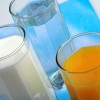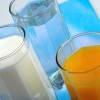The objective of this new 5-page guide is to provide information on how to successfully carbonate beverages on a small scale. Included is information on the benefits of carbonation, common carbonation levels, pros and cons of different carbonation methods, standard procedures to achieve a specific carbonation level, and economic considerations for manufacturers. Written by Xuwei Song, Nicholas Wendrick, Charles A. Sims, and Andrew MacIntosh, and published by the UF/IFAS Food Science and Human Nutrition Department.
https://edis.ifas.ufl.edu/fs379
Tag: Beverages
Butterfly Pea (Clitoria ternatea) Flower Extract (BPFE) and Its Use as a pH-Dependent Natural Colorant
Butterfly pea (Clitoria ternatea), a twining vine native to Southeast Asia, produces deep blue to purple flowers that bloom nearly year-round in ideal conditions. When extracted in a liquid, the addition of a mild acid such as lemon or lime juice turns the naturally deep blue to purple color into a much lighter pink or purple color, giving the extract its color-changing ability. This new 5-page publication of the UF/IFAS Environmental Horticulture Department outlines the use of butterfly pea flower extract (BPFE) as a pH-dependent natural colorant, including an explanation of the science behind the color change, detailed parameters for flower extraction, instructions for storage and processing of the extract as well as a discussion of some of the other benefits of using BPFE. Written by Sean Michael Campbell and Brian Pearson.
http://edis.ifas.ufl.edu/ep573
Healthy Eating: Fluids
 More than one-half of an adult’s body weight is water. Water brings nutrients to the cells in our bodies and removes waste. Our bodies cannot function if they do not receive enough water. This 2-page fact sheet is a major revision that addresses the importance of water to physical functions, effects of dehydration, risk factors for dehydration in older adults, and fluid intake suggestions. Written by Linda B. Bobroff, and published by the UF Department of Family, Youth and Community Sciences, revised June 2016.
More than one-half of an adult’s body weight is water. Water brings nutrients to the cells in our bodies and removes waste. Our bodies cannot function if they do not receive enough water. This 2-page fact sheet is a major revision that addresses the importance of water to physical functions, effects of dehydration, risk factors for dehydration in older adults, and fluid intake suggestions. Written by Linda B. Bobroff, and published by the UF Department of Family, Youth and Community Sciences, revised June 2016.
http://edis.ifas.ufl.edu/fy070
Healthy Eating: Fluids (FCS8569/FY070)
 More than one-half of an adult human body weight is water. Water brings nutrients to the cells in our bodies and removes waste. Our bodies cannot function without an adequate water supply. This 2-page fact sheet was written by Linda B. Bobroff, Luisa Oliver-Cordero, and Emily Minton, and published by the UF Department of Family Youth and Community Sciences, 10. http://edis.ifas.ufl.edu/fy070
More than one-half of an adult human body weight is water. Water brings nutrients to the cells in our bodies and removes waste. Our bodies cannot function without an adequate water supply. This 2-page fact sheet was written by Linda B. Bobroff, Luisa Oliver-Cordero, and Emily Minton, and published by the UF Department of Family Youth and Community Sciences, 10. http://edis.ifas.ufl.edu/fy070
Alimentacion Saludable: Liquidos (FCS8569Span/FY071)
 Más de la mitad del peso del cuerpo humano adulto, es agua. El agua transporta nutrientes a las células en nuestros cuerpos y remueve los residuos. Nuestros cuerpos no podrían funcionar sin una fuente de agua adecuada. This 2-page fact sheet was written by Linda B. Bobroff, Luisa Oliver-Cordero, y Emily Minton, and published by the UF Department of Family Youth and Community Sciences, October 2012.
Más de la mitad del peso del cuerpo humano adulto, es agua. El agua transporta nutrientes a las células en nuestros cuerpos y remueve los residuos. Nuestros cuerpos no podrían funcionar sin una fuente de agua adecuada. This 2-page fact sheet was written by Linda B. Bobroff, Luisa Oliver-Cordero, y Emily Minton, and published by the UF Department of Family Youth and Community Sciences, October 2012.
http://edis.ifas.ufl.edu/fy071
Healthy Eating: Healthier Beverage Options (FCS80011/FY1308)
 Use this chart to help replace beverages high in sugar or fat with healthier alternatives. Written by Emily Minton, and published by the UF Department of Family Youth and Community Sciences, March 2012. http://edis.ifas.ufl.edu/fy1308
Use this chart to help replace beverages high in sugar or fat with healthier alternatives. Written by Emily Minton, and published by the UF Department of Family Youth and Community Sciences, March 2012. http://edis.ifas.ufl.edu/fy1308
Alimentación Saludable: Bebidas saludables (FCS8694Span/FY697)
 Los batidos son una manera deliciosa de incorporar más frutas y nutrientes a su dieta. This 2-page fact sheet was written by Jennifer Hillan and Emily Minton, and published by the UF Department of Family Youth and Community Sciences, March 2012.
Los batidos son una manera deliciosa de incorporar más frutas y nutrientes a su dieta. This 2-page fact sheet was written by Jennifer Hillan and Emily Minton, and published by the UF Department of Family Youth and Community Sciences, March 2012.
http://edis.ifas.ufl.edu/fy697
Healthy Eating: Drink to Your Health (FCS8694/FY696)
 Shakes and smoothies are a great and tasty way to incorporate more fruits and nutrients into your diet. This 2-page fact sheet was written by Jennifer Hillan and Emily Minton, and published by the UF Department of Family Youth and Community Sciences, March 2012.
Shakes and smoothies are a great and tasty way to incorporate more fruits and nutrients into your diet. This 2-page fact sheet was written by Jennifer Hillan and Emily Minton, and published by the UF Department of Family Youth and Community Sciences, March 2012.
http://edis.ifas.ufl.edu/fy696

